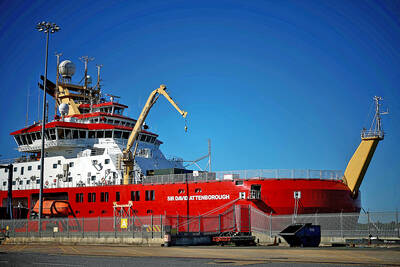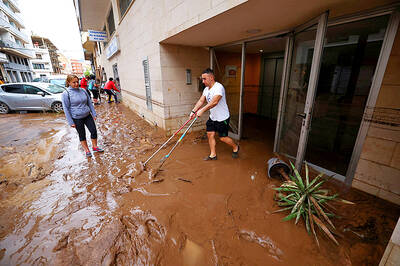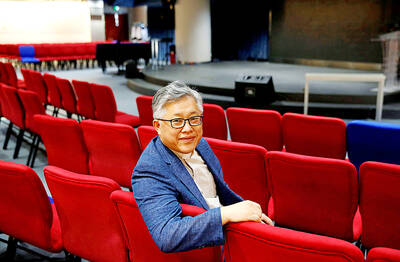Rescuers pulled the final survivors from the gnarled wreckage of Japan's worst train crash in decades yesterday as investigators raided rail operator offices for clues about why the train skidded from the tracks, killing 73 people.
Power shovels picked at the piles of twisted railway cars and debris, peeling away layers of crushed metal to allow better access to the two train cars flattened against an apartment building that the train slammed into during Monday's deadly accident in Amagasaki.
Agents swarmed eight offices of West Japan Railway Co, carting away cardboard boxes of documents, as media reports said the company's top executives were expected to resign. The probe into possible professional negligence has focused on the actions of the 23-year-old driver -- who has not yet been accounted for -- and the speed of the train.

PHOTO: AFP
Workers freed two survivors from the wreckage early yesterday, and police said they did not expect to find anyone else alive. Police wouldn't comment on media reports that workers had found at least 10 more people, all feared dead.
Hiroki Hayashi, 19, was sprung from a damaged car after surviving the night with the help of an intravenous drip and drinking water.
"I'm in pain, I can't take it anymore," he told his mother in a cell phone call after the crash, according to his 18-year-old brother Takamichi Hayashi.
Hiroki Hayashi was injured in the leg and was conscious and in stable condition at a hospital as of yesterday afternoon.
Victims' relatives struggled to comprehend their loss.
"I wish it were only a nightmare," Hiroko Kuki, whose son Tetsuji was killed in the crash, told public broadcaster NHK. "I only saw him the night before ... I wish he were alive somewhere."
In northern Japan, the lead car of a passenger train jumped the tracks when it crashed into a trailer at a crossing at Nimori yesterday in the second derailment in two days. The trailer's driver was slightly hurt.
The seven-car train that crashed Monday in Amagasaki was packed with 580 passengers when it jumped the tracks near this Osaka suburb and plunged into the first floor of an apartment complex. At least 456 people were injured.
About 10 government inspectors launched their accident investigation yesterday by examining tracks. They also planned to recover a recorder with data on the train's speed and other details at the time of the accident, said Mr. Shimoda, a Transportation Ministry inspector who gave only his family name.
Monday's accident occurred at a curve after a straightaway. Passengers speculated that the driver may have been speeding to make up for lost time after overshooting the previous station.
The train was nearly two minutes behind schedule, company officials said.
The driver -- identified as Ryujiro Takami -- had obtained his train operator's license in May last year. One month later, he overran a station and was issued a warning for his mistake, railway officials and police said.
They were investigating the case as possible professional negligence by the train operator, West Japan Railway Co, a prefectural police spokesman said on condition of anonymity.
JR West president, Takeshi Kakiuchi, and other top executives were likely to announce their resignation today at a board of directors' meeting originally scheduled to discuss earnings, the Nihon Keizai reported.
Tsunemi Murakami, the JR West safety director, said he instructed company employees to "fully cooperate" with police investigation to look into the cause of the accident.
"We take it seriously because of a large accident like this," he said.
Deadly train accidents are rare in Japan. Monday's accident was the worst rail disaster in nearly 42 years in safety-conscious Japan, which is home to one of the world's most complex, efficient and heavily traveled rail networks. A three-train crash in November 1963 killed 161 people in Tsurumi, outside Tokyo.

STEPPING UP: Diminished US polar science presence mean opportunities for the UK and other countries, although China or Russia might also fill that gap, a researcher said The UK’s flagship polar research vessel is to head to Antarctica next week to help advance dozens of climate change-linked science projects, as Western nations spearhead studies there while the US withdraws. The RRS Sir David Attenborough, a state-of-the-art ship named after the renowned British naturalist, would aid research on everything from “hunting underwater tsunamis” to tracking glacier melt and whale populations. Operated by the British Antarctic Survey (BAS), the country’s polar research institute, the 15,000-tonne icebreaker — boasting a helipad, and various laboratories and gadgetry — is pivotal to the UK’s efforts to assess climate change’s impact there. “The saying goes

Floods on Sunday trapped people in vehicles and homes in Spain as torrential rain drenched the northeastern Catalonia region, a day after downpours unleashed travel chaos on the Mediterranean island of Ibiza. Local media shared videos of roaring torrents of brown water tearing through streets and submerging vehicles. National weather agency AEMET decreed the highest red alert in the province of Tarragona, warning of 180mm of rain in 12 hours in the Ebro River delta. Catalan fire service spokesman Oriol Corbella told reporters people had been caught by surprise, with people trapped “inside vehicles, in buildings, on ground floors.” Santa Barbara Mayor Josep Lluis

Police in China detained dozens of pastors of one of its largest underground churches over the weekend, a church spokesperson and relatives said, in the biggest crackdown on Christians since 2018. The detentions, which come amid renewed China-US tensions after Beijing dramatically expanded rare earth export controls last week, drew condemnation from US Secretary of State Marco Rubio, who on Sunday called for the immediate release of the pastors. Pastor Jin Mingri (金明日), founder of Zion Church, an unofficial “house church” not sanctioned by the Chinese government, was detained at his home in the southern city of Beihai on Friday evening, said

The Venezuelan government on Monday said that it would close its embassies in Norway and Australia, and open new ones in Burkina Faso and Zimbabwe in a restructuring of its foreign service, after weeks of growing tensions with the US. The closures are part of the “strategic reassignation of resources,” Venezueland President Nicolas Maduro’s government said in a statement, adding that consular services to Venezuelans in Norway and Australia would be provided by diplomatic missions, with details to be shared in the coming days. The Norwegian Ministry of Foreign Affairs said that it had received notice of the embassy closure, but no